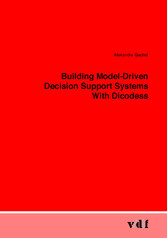Suchen und Finden
5 Motivation (p. 73-74)
The concept of decision support has evolved from two main areas of research: the theoretical studies of organizational decision making done at the Carnegie Institute of Technology during the late 1950s and early 1960s, and the technical work on interactive computer systems, mainly carried out at the Massachusetts Institute of Technology in the 1960s (Keen and Scott Morton 1978). It is commonly considered that this convergence of theoretical studies and technical work found its realization in the middle of the 1970s, when the concept of decision support systems (DSS) became an area of research of its own. However, thirty years later, strong indications show that theory and technique did not really converge, at least in some fields of decision support.
The parallel evolution of multiparticipant decision making theory and distributed computing exemplifies this situation. Many multiparticipant DSS today are either completely out of phase with the distributed technology (that is, they are designed as local, desktop applications) or based on simple, centralized distributed network topologies. Consequently, the DSS research field still needs new solutions to bring the multiparticipant decision making concepts in line with the latest advances in distributed technology.
5.1 Purpose
The main goal of this research is to design and implement a computer-based solution for a well-defined multiparticipant decision making process evolving in a distributed, highly decentralized environment. The three main concepts of this statement are briefly described in the next paragraphs of this section. First, a lot of research has already been conducted in the field of DSS development. The traditional system development life cycle (SDLC) approach is often mentioned in DSS literature (for example, Marakas 1999; Power 2002a). Other approaches, more specific to DSS development, have also been defined, among whose a progressive approach (Courbon, Drageof et al. 1979), the functional category analysis (Blanning 1979), the ROMC analysis (Sprague and Carlson 1982), the DSS development process (Marakas 1999), rapid prototyping, and end-user development (Kreie, Cronan et al. 2000).
However, all of these approaches mostly focus on the development of unique, specific DSS. In that sense, the field of DSS still needs computer-based solutions enhancing the ideas of software reuse, modularity, precustomization, customizability, and reduced develop- ment time. The need for such solutions is topical, as the underlying technology is itself constantly becoming more complex (Pratt 2000). Software engineering provides several kinds of computer-based solutions to solve problems (from methodologies to complete applications, via software processes, design patterns, architectural styles, code libraries, toolkits, software frameworks, etc.). It is part of this research to find the best combination of these possible solutions in the current context. Next, given the broad nature of the field of DSS, it is of utmost importance to understand that it would be utopian to try to define a "one size fits all" computer-based solution applicable to many different decision processes, in many different decision making situations. Several factors such as the intrinsic nature of the problem to be solved, the technical knowledge of the end-users of the systems, the level of communication required between the actors, or purely technical constraints applied to the underlying infrastructure define completely different decision making processes and environments, which require the design and implementation of different computer-based solutions.
This research focuses on a well defined decision process, which allows multiple actors to actively structure semi-structured problems. This happens by dynamically generating optimization models. The exact process is described in Section 5.2.1, Structuring Semi- Structured Decision Problems. Moreover, this research focuses on a decision process that is currently not appropriate for data intensive systems, such as Executive Information Systems (EIS) or data warehouses. This last point is explained in Section 10.2.1, Data-Related Requirements.
Alle Preise verstehen sich inklusive der gesetzlichen MwSt.








